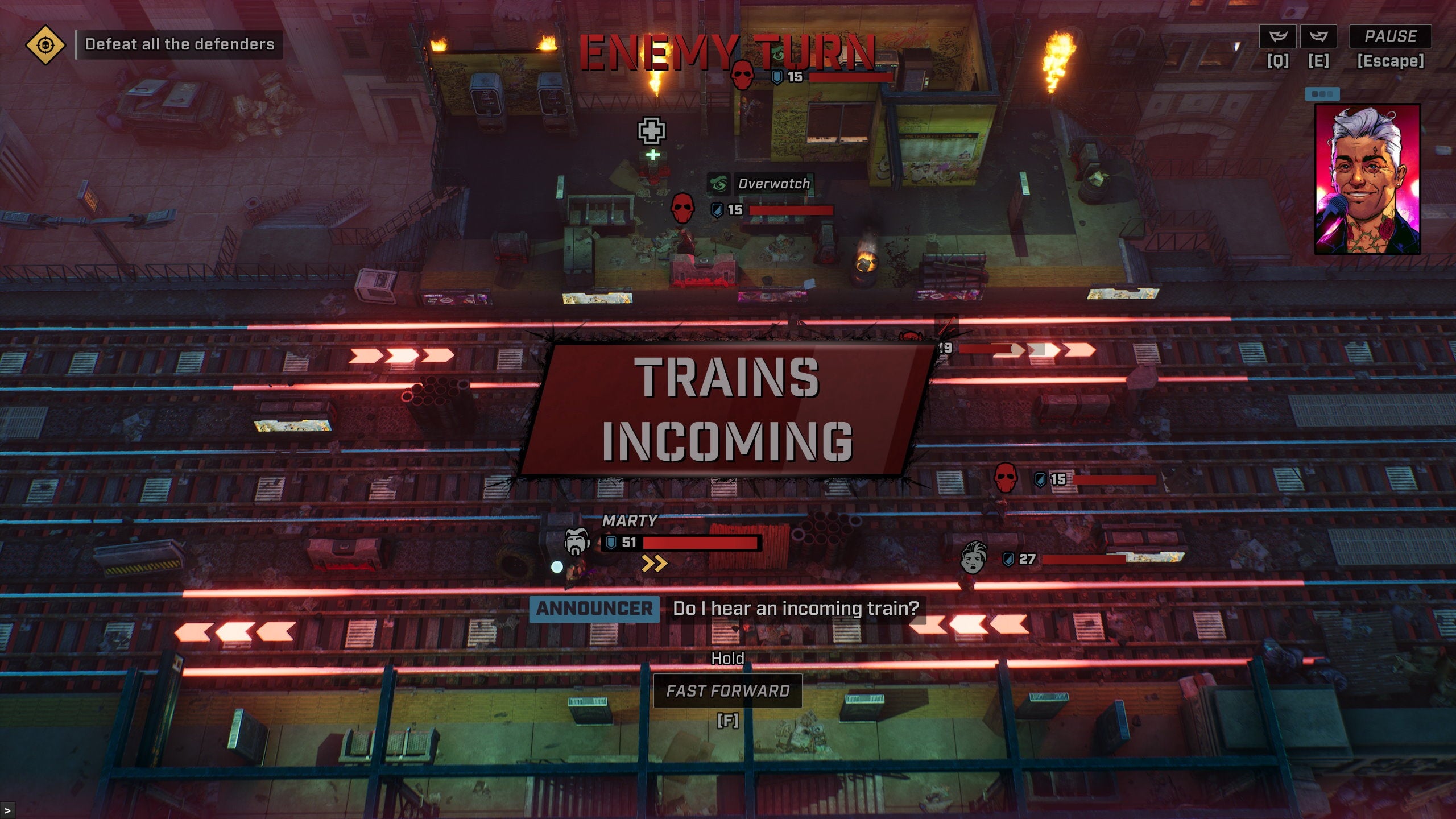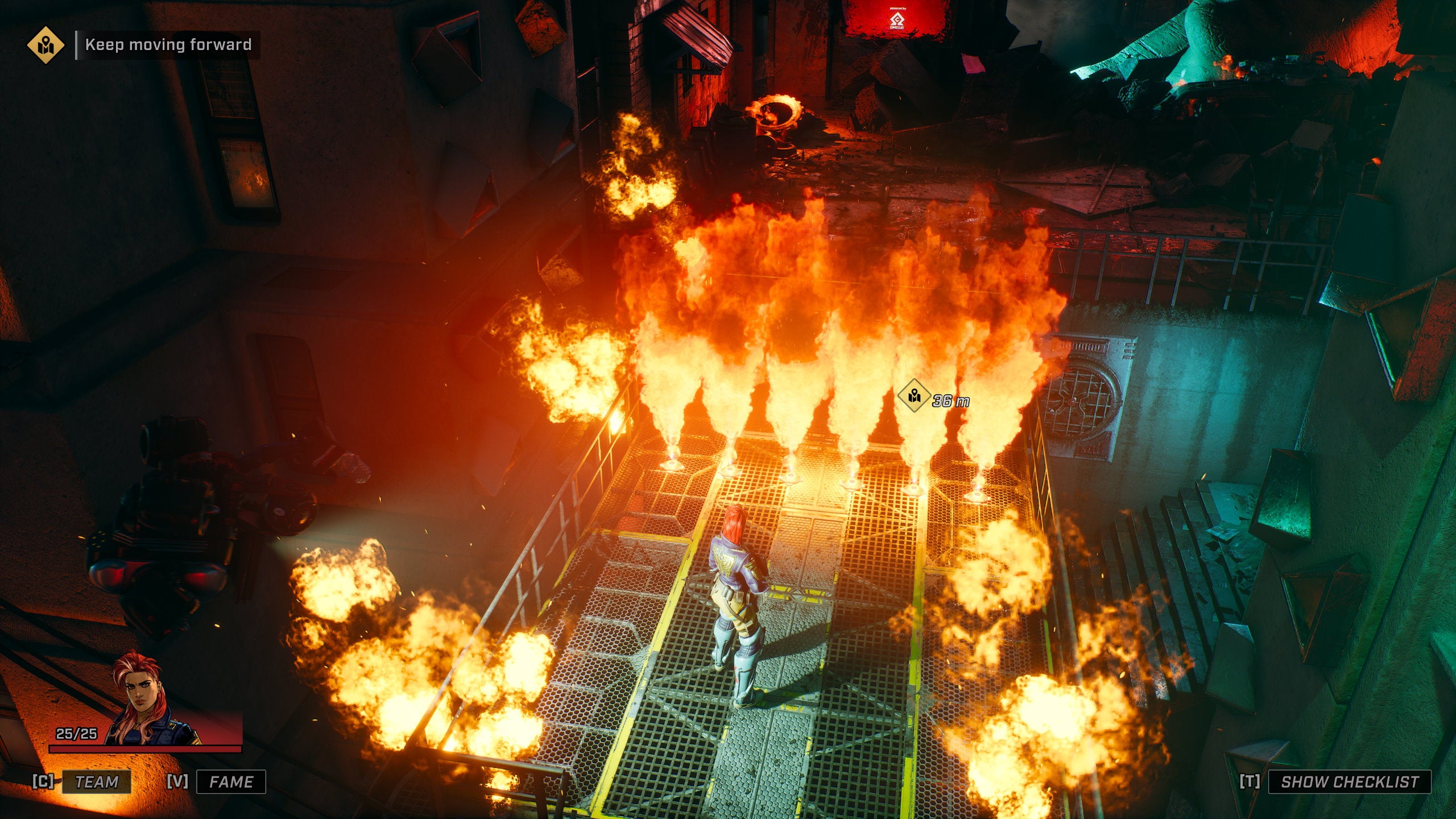For Scarlett, this means mowing down scumbags in classic turn-based fashion with a bunch of other friendly competitors she’s teamed up with, but this is far from a straightforward XCOM-like. Between fights, you’ll also be navigating its trap-filled arenas in third-person, dodging sniper turrets, disabling tripwires, and dashing over spiky/fiery/horrible pits to get to the end of each ’episode’. It’s a refreshing mix based on an early preview build I’ve been playing recently, especially when its gameshow hook allows for its malicious host, Orion Ford, to start meddling with your success. “He’s the person behind the worst of the twists,” creative director and Artificer CEO Kacper Szymczak tells me. “He’ll start filling the level with poisonous gas, he’ll turn off the lights, drop explosive barrels everywhere, to name just a few.” Ford isn’t some Left 4 Dead-style director figure, though. Describing him as “part-narrative figure, part-gameplay mechanic”, Szymczak explains that the team “chose to stay away from a systemic approach with infinite replayability, and instead chose to focus on creating an exciting rollercoaster ride for the player where we can make sure every encounter is unique and fun.” And yes, in practice, Ford’s interferences do seem to be entirely scripted rather than randomly happening on the fly. At one point, for example, Scarlett goes to grab a key that will unlock the next arena in the episode, but Ford decides this isn’t exciting enough for the audience, so he transforms the area into a Temple Of Doom-like spike prison, forcing Scarlett to seek shelter in a teeny tiny (but very obviously framed) alcove behind an intermittent wall of flames. Or at least that’s true of the single-player campaign. In perhaps a fitting move for its spectator-driven bloodsport, Homicidal All-Stars will also have a dedicated Twitch mode at launch which will let a streamer’s audience take on the role of the show director themselves. “They get to mess with the contenders’ game to make it more entertaining to watch by voting on new obstacles, tougher enemies, and all other sorts of complications, or - if they’re feeling merciful - maybe even a bit of help,” says Szymczak. (Un)fortunately, I only had the regular campaign available in my preview build, so we’ll have to wait and see how this side of the game turns out closer to launch. As someone who’s averse to streaming in all its forms, it’s not something I’ll be partaking in personally, but the fact it even exists as a separate mode to the campaign shows a marked change in approach from Szymczak and his team’s earlier work. When I asked him where the idea for Homicidal All-Stars first came from, the direction of the game was very clear from early on. “From the get-go, we knew we wanted this to be a fast (as opposed to Hard West), brutal, and streamlined tactical experience. We knew what setting would be perfect for the vision we had - a futuristic urban environment, with a sound geometry and a subtle science fiction flavor that would give us the creative breathing room input whatever we desired, both visually and gameplay-wise. We knew we wanted to create a retro-futuristic cyberpunk environment, something that rekindled our love of the early 90s, and with it all the things that surrounded us in our childhood.” All they needed was a central idea tying it all together. “We had our whole team come up with ideas for this unifying idea that could capture our audience and make a thrilling game experience. Hats off to our producer, Sebastian Hitchinson, for coming up with the brutal TV game show idea. It’s a perfect setting for creative liberation. After all, literally anything can happen on TV and still make sense. It’s supposed to be a spectacle where anything goes - including a level littered with exploding barrels. Where else does it make as much sense as on a TV game show?” It’s certainly a very different vibe to the first Hard West, that’s for sure, and Szymczak says his team has been consciously trying to remove any “filler” from getting in the way of the combat. “As you explore, you discover battle arenas (some of them mandatory, some optional): stock up, load out and go in,” he tells me. “Definitely more up the Into The Breach alley than, say, XCOM - the battle arenas are carefully hand-crafted combat experiences, there’s always a sequence of events, enemy reinforcements, twists, turns and other curve balls thrown your way, and there’s plenty of ways to approach them. […] Walking up to the enemies from a distant point at the beginning and killing off stragglers at the end is hardly the fun part of combat. That’s why it’s kept to a minimum in Homicidal All-Stars, with the majority of the players’ moves having an actual impact on the battlefield.” Admittedly, I didn’t get to see much of those ‘impactful’ abilities Szymczak mentioned during my preview build, which covered the very beginning of the game, but when each character only has two action points to spend per turn, you’ll definitely need to make each move count if you’re going to survive. Similar to Gears Tactics, each character has their own ammo stocks you’ll need to manage, as well as special abilities that take time to cooldown once they’ve been used. Scarlett’s signature move, for example, still lets her shoot after using both of her action points, while Marty’s shotgun has a spread attack that hits multiple foes at once. Both of them can also enter overwatch, although the lack of vision cones certainly threw me for a loop when I first tried to use it. Instead, overwatch covers a preset range of tiles in Homicidal All-Stars, which are highlighted on the floor before you select it. While I appreciate this takes some of the faff out of positioning said overwatch cones, it did grate a little that I didn’t have full control over it at first, as I felt like it was robbing me of the chance to cover particular choke points, or just trying to nobble certain characters I had my eye on. As my demo went on, however, it annoyed me less and less, and that’s partly down to the small, intimate nature of Homicidal All-Stars’ battle arenas. These combat zones are tight, self-contained levels abounding in full and half-height cover objects, but there’s precious little room to turtle and take pot-shots from afar. Indeed, some enemies, such as the smokescreen-packing Fumer, are immune to long-range shots while they’re obscured in their gassy havens, forcing players out of cover to deploy their (perhaps too) powerful melee attacks. Another stage also had a three-way train track plonked in the middle of it, requiring players to get out of the way every couple of turns lest they be turned into a streak of mulch. It’s fast, breezy fun that’s made all the more enjoyable by having such a clear and informative interface. “We’ve invested tons of effort into making sure the UX is top-notch,” says Szymczak, and it shows, with constantly updating hit percentages appearing over enemy noggins as you move your cursor around the map, clearly highlighted areas of effect for special abilities and grenades, and gun attacks greying out when you run out of ammo. This attention to detail extends to the game’s exploration sections as well, with interactive elements such as tripwires and loot boxes all gaining their own individual highlight rings to help players pick them out of the murk of the set when they’re nearby. You’ll still need to keep your eyes peeled for these traps, I should add, but the extra visual assistance is certainly welcome. Between episodes, meanwhile, you’ll be kicking back in the production studio’s rest area, chatting to your fellow teammates and levelling up your stats. At first glance, there doesn’t seem to be any kind of XCOM-style strategy layer to contend with here, but Szymczak does tease that “Things are not always what they seem…” in these moments of downtime. I suspect he’s referring to the game’s underlying story beats here, rather than some secret TV production studio to manage and upgrade later on in the game, for example, but what I’ve seen of the story so far has at least piqued my interest. Scarlett’s story seems to be a classic murdered family revenge story, but former HAS champ Marty is a lot more enigmatic. I’m also keen to see how the game resolves the whole ‘contestants working together’ schtick, and whether, like Squid Game, players will be forced to break their alliances as the show progresses. Squid Game genuinely made me tear up at several points during its final episodes, so I’ll be impressed if Homicidal All-Stars manages to get me blubbering in the same way. All in all(-stars), then, Artificer’s debut looks promising. Bar that minor overwatch niggle, the way it blends so many great strategy games together makes for some very satisfying combat sections, and its on-foot puzzle-solving helps break up the tension between scraps, feeding back into the story without feeling like too much “filler”. Its tone is certainly a lot more abrasive than Hard West and Phantom Doctrine, but in an increasingly saturated genre, perhaps that’s what’s needed to stand out from the crowd. Luckily, you can find out for yourself next week, as Homicidal All-Stars is getting a free Steam demo as part of Steam Next Fest, which runs from October 3rd-10th.



